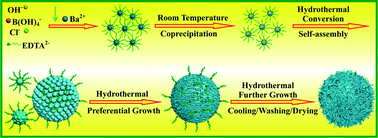Hierarchical Ba2(B5O9)Cl·(H2O)0.5 microspheres: surfactant-assisted facile hydrothermal synthesis, Tb3+ doping and photoluminescence properties†
Abstract
Three-dimensional hierarchical nanoarchitectures of metal borates self-assembled by one-dimensional or two-dimensional nanostructures have been paid extensive attention for their versatile compositions and excellent performance in various fields. Hilgardite-like metal borates have been widely employed as nonlinear optical materials and ideal hosts for various luminescent ions. In this contribution, we reported for the first time a mild surfactant-assisted hydrothermal process for the synthesis of uniform Ba2(B5O9)Cl·(H2O)0.5 microspheres at 160 °C for 6.0 h, by using BaCl2·2H2O, H3BO3, and NaOH as raw materials and ethylenediaminetetraacetic acid disodium salt (EDTA-2Na) as the surfactant. The effects of process parameters and the EDTA-2Na assisted formation mechanism were investigated in detail. The as-obtained microspheres exhibited a transparent characteristic from the ultraviolet to visible range. Within the experimental doping molar percentage of 0–10% in Ba2+, the as-prepared Ba2(B5O9)Cl·(H2O)0.5:6%Tb3+ phosphors demonstrated the strongest PL intensity, revealing the as-obtained Ba2(B5O9)Cl·(H2O)0.5 microspheres as a great promising host candidate for emitting luminescent materials in light display systems or optoelectronic devices.


 Please wait while we load your content...
Please wait while we load your content...